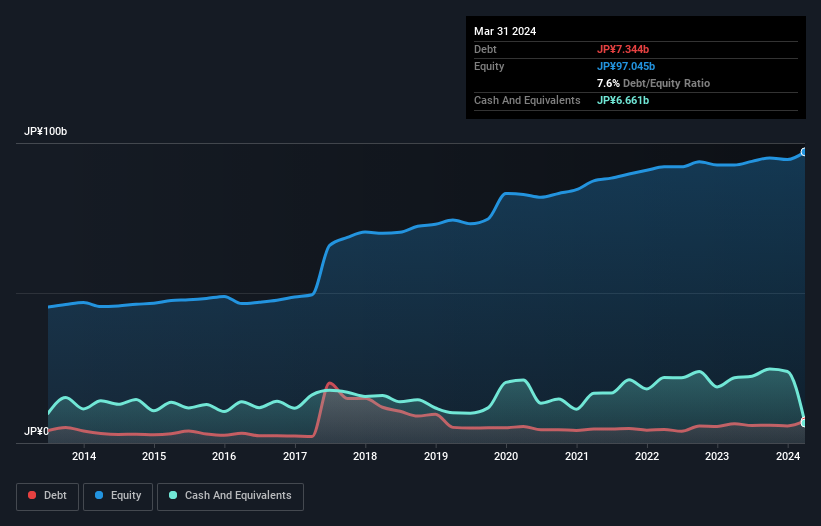
Legendary fund manager Li Lu (who Charlie Munger backed) once said, 'The biggest investment risk is not the volatility of prices, but whether you will suffer a permanent loss of capital.' When we think about how risky a company is, we always like to look at its use of debt, since debt overload can lead to ruin. We can see that C.I.TAKIRON Corporation (TSE:4215) does use debt in its business. But should shareholders be worried about its use of debt?
When Is Debt Dangerous?
Debt and other liabilities become risky for a business when it cannot easily fulfill those obligations, either with free cash flow or by raising capital at an attractive price. In the worst case scenario, a company can go bankrupt if it cannot pay its creditors. While that is not too common, we often do see indebted companies permanently diluting shareholders because lenders force them to raise capital at a distressed price. Of course, the upside of debt is that it often represents cheap capital, especially when it replaces dilution in a company with the ability to reinvest at high rates of return. The first step when considering a company's debt levels is to consider its cash and debt together.
Check out our latest analysis for C.I.TAKIRON
What Is C.I.TAKIRON's Net Debt?
You can click the graphic below for the historical numbers, but it shows that as of March 2024 C.I.TAKIRON had JP¥7.34b of debt, an increase on JP¥6.42b, over one year. However, it does have JP¥6.66b in cash offsetting this, leading to net debt of about JP¥683.0m.

How Healthy Is C.I.TAKIRON's Balance Sheet?
We can see from the most recent balance sheet that C.I.TAKIRON had liabilities of JP¥48.1b falling due within a year, and liabilities of JP¥11.0b due beyond that. On the other hand, it had cash of JP¥6.66b and JP¥48.5b worth of receivables due within a year. So its liabilities total JP¥4.01b more than the combination of its cash and short-term receivables.
Of course, C.I.TAKIRON has a market capitalization of JP¥72.4b, so these liabilities are probably manageable. But there are sufficient liabilities that we would certainly recommend shareholders continue to monitor the balance sheet, going forward. But either way, C.I.TAKIRON has virtually no net debt, so it's fair to say it does not have a heavy debt load!
We use two main ratios to inform us about debt levels relative to earnings. The first is net debt divided by earnings before interest, tax, depreciation, and amortization (EBITDA), while the second is how many times its earnings before interest and tax (EBIT) covers its interest expense (or its interest cover, for short). The advantage of this approach is that we take into account both the absolute quantum of debt (with net debt to EBITDA) and the actual interest expenses associated with that debt (with its interest cover ratio).
With debt at a measly 0.059 times EBITDA and EBIT covering interest a whopping 36.0 times, it's clear that C.I.TAKIRON is not a desperate borrower. Indeed relative to its earnings its debt load seems light as a feather. Fortunately, C.I.TAKIRON grew its EBIT by 7.5% in the last year, making that debt load look even more manageable. There's no doubt that we learn most about debt from the balance sheet. But it is C.I.TAKIRON's earnings that will influence how the balance sheet holds up in the future. So when considering debt, it's definitely worth looking at the earnings trend. Click here for an interactive snapshot.
Finally, a company can only pay off debt with cold hard cash, not accounting profits. So the logical step is to look at the proportion of that EBIT that is matched by actual free cash flow. In the last three years, C.I.TAKIRON's free cash flow amounted to 43% of its EBIT, less than we'd expect. That's not great, when it comes to paying down debt.
Our View
C.I.TAKIRON's interest cover suggests it can handle its debt as easily as Cristiano Ronaldo could score a goal against an under 14's goalkeeper. And that's just the beginning of the good news since its net debt to EBITDA is also very heartening. When we consider the range of factors above, it looks like C.I.TAKIRON is pretty sensible with its use of debt. While that brings some risk, it can also enhance returns for shareholders. When analysing debt levels, the balance sheet is the obvious place to start. But ultimately, every company can contain risks that exist outside of the balance sheet. We've identified 2 warning signs with C.I.TAKIRON (at least 1 which is significant) , and understanding them should be part of your investment process.
If you're interested in investing in businesses that can grow profits without the burden of debt, then check out this free list of growing businesses that have net cash on the balance sheet.
New: AI Stock Screener & Alerts
Our new AI Stock Screener scans the market every day to uncover opportunities.
• Dividend Powerhouses (3%+ Yield)
• Undervalued Small Caps with Insider Buying
• High growth Tech and AI Companies
Or build your own from over 50 metrics.
Have feedback on this article? Concerned about the content? Get in touch with us directly. Alternatively, email editorial-team (at) simplywallst.com.
This article by Simply Wall St is general in nature. We provide commentary based on historical data and analyst forecasts only using an unbiased methodology and our articles are not intended to be financial advice. It does not constitute a recommendation to buy or sell any stock, and does not take account of your objectives, or your financial situation. We aim to bring you long-term focused analysis driven by fundamental data. Note that our analysis may not factor in the latest price-sensitive company announcements or qualitative material. Simply Wall St has no position in any stocks mentioned.
About TSE:4215
C.I.TAKIRON
Engages in the construction materials, environmental materials, high functional materials, and specialty films businesses in Japan.
Excellent balance sheet with proven track record and pays a dividend.

